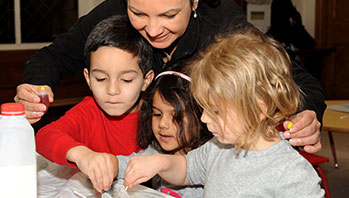- camera
- clipboards
- digging tools or sticks
- garden hose
- markers
- paper
- water containers (plastic buckets, bottles, and cups)
- flow
- pour
- puddle
- river
MA Standards:
Language/L.PK.MA.6: Use words and phrases acquired through conversations, listening to books read aloud, activities, and play.
MA Draft STE Standards:
Earth and Space Sciences/Earth’s Systems/ESS2.A: Observe, investigate, and classify the non-living materials, natural and human made, in their environment.
Head Start Outcomes
Logic and Reasoning/Reasoning and Problem Solving: Classifies, compares, and contrasts objects, events, and experiences.
Science Knowledge/Conceptual Knowledge of Natural and Physical Worlds: Observes, describes, and discusses properties of materials and transformation of substances.
PreK Learning Guidelines:
English Language Arts/Language 2: Participate actively in discussions, listen to the ideas of others, and ask and answer relevant questions.
Science and Technology/Physical Sciences 19: Explore, describe, and compare the properties of liquids and solids found in children's daily environment.
Small Group: Change the Flow

© Commonwealth of Massachusetts, Department of Early Education and Care (Jennifer Waddell photographer). All rights reserved.
STEM Key Concepts: Water flows downhill; You can change the direction water flows; You can use different objects to move water
ELA Focus Skills: Listening and Speaking, Vocabulary
Take children outside to continue exploring how to change the direction of water flow. Before you begin pouring water, help children collect materials that they can use to change the flow of water.
Explain to children how they can use the materials to block the flow of water or change the flow of the water. Ask,
- What do you think will happen if I put this big rock across the water path? Let’s try it. Pour the water down and have children discuss results.
- How do you think we can change the path of the river and create new puddles? Start the river flowing after children have responded and have them try out their predictions.
After children have explored, ask,
- Which materials worked best for stopping the flow completely? Why do you think those worked the best?
- Which materials worked best for changing the direction of the flow?
- Which materials did not change the flow of water the way you predicted they might? Why do you think that is?
